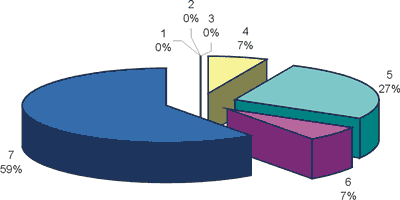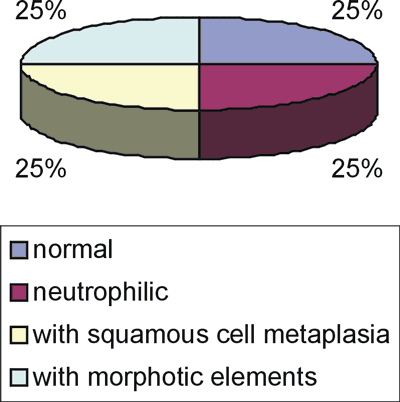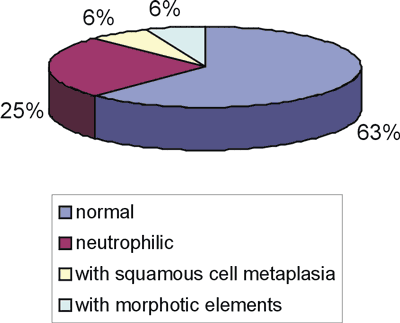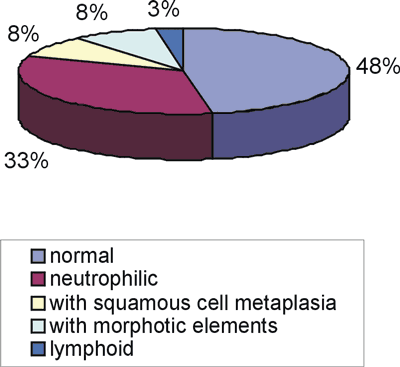© Borgis - New Medicine 3/2006, s. 71-73
Mieczysław Chmielik, Eliza Brożek-Mądry, Lechosław P. Chmielik
Influence of the type of septum deviation on some parameters in the upper airways
Department of Paediatric Otorhinolaryngology, Medical University in Warsaw
Head of Department: Prof. Mieczysław Chmielik, MD, PhD
Summary
Summary
Views on nasal septum deviation are diverse and subject to its localisation and configuration. A classification that takes into consideration both location and character of the deviation is the Mladina classification. The aim of this paper is to evaluate the influence of localisation and configuration of nasal septum deviation on nasal patency and nasal cytology. A group of children, qualified for plastic nasal septum surgery and collected in years 2005 and 2006, underwent rhinomanometric evaluation and nasal cytology from both nasal cavities.
INTRODUCTION
Views on nasal septum deviation are diverse and subject to its localisation and configuration. A classification that takes into consideration both location and character of the deviation is the Mladina classification. The authors of this paper put the question whether such heterogeneity affects the upper respiratory airway based on nasal cytology and rhinomanometry.
AIM
The aim of this paper is to evaluate the influence of localisation and configuration of nasal septum deviation on nasal patency and nasal cytology.
MATERIALS AND METHODS
A group of 30 children aged 8-17 (mean age 14.1), qualified for plastic nasal septum surgery, was collected in years 2005 and 2006. All of the patients in this group underwent rhinomanometric evaluation with apparatus Rhino Mini ABC, and nasal cytology from both nasal cavities was evaluated. Cytology was obtained by scraping from lower nasal concha, approx. 1 cm past the anterior pole, analogically on both sides. Exfoliated material was transferred onto the microscope slides, fixed with alcohol and dyed with haematoxylin-eosine.
The collected group of children with nasal septum deviation was divided according to the type of deviation in the Mladina classification. The side with nasal patency impaired due to septum deviation was marked. In these subgroups rhinomanometry and cytology were performed. Cytologic evaluation was done to report the presence of alluvial cells such as neutrophils, lymphocytes, eosinophils, monocytes and squamous epithelium, goblet cells, columnar epithelium and basal cell epithelium.
RESULTS
No children in the study group were classified to 1st, 2nd, or 3rd group according to Mladina´s classification. In the next types of septum deviation the following results were noted:

Fig. 1. Nasal septum deviation according to Mladina in the studied group (type 1-7).
1. Type 4 (2 patients) (Fig. 2):
– 1 normal cytogram
– 1 neutrophilic cytogram
– 1 with squamous metaplasia
– 1 with morphotic elements
Rhinomanometric evaluation did not find an increase in nasal cavity resistance.

Fig. 2. Type 4 according to Mladina´s classification (2 patients).
2. Type 5 (8 patients) (Fig. 3):
– 10 normal cytograms
– 4 neutrophilic cytograms
– 1 with squamous cell metaplasia
– 1 with morphotic elements.
Among the normal cytograms two showed elevated numbers of neutrophils and a further two had features of squamous cell metaplasia. In rhinomanometry 43% of patients showed nasal patency disorders.

Fig. 3. Type 5 according to Mladina (8 patients).
3. Type 6 (2 patients) (Fig. 4):
– 2 neutrophilic cytograms
– 1 normal cytogram with a tendency towards neutrophilic
– 1 cytogram with morphotic elements
Rhinomanometric evaluation showed increased nasal resistance in the whole subgroup.

Fig. 4. Type 6 according to Mladina (2 patients).
4. Type 7 (18 patients) (Fig. 5):
– 17 normal cytograms,
– 12 neutrophilic cytograms,
– 3 cytogram with squamous cell metaplasia,
– 3 with morphotic elements
– 1 lymphoid cytogram.

Fig. 5. Type 7 according to Mladina (18 patients).
In 28% (5 patients) the cytogram was similar on both sides. Two of the normal cytograms had features of squamous cell metaplasia with increased numbers of neutrophils, and a further two presented increased numbers of neutrophils only, one with features of squamous cell metaplasia, and one with increased number of basal cells. Two patients with neutrophilic cytogram had eosinophilia over 5% – only one of them was earlier diagnosed with allergic rhinitis.
Rhinomanometric evaluation showed increased nasal resistance in 75%.
In a significant majority of patients the cytograms were different on both sides. There was no correlation noticed between the side deviated and the cytology result.
CONCLUSIONS
1. Nasal septum deviation interferes with nasal mucous membrane cytology at least on one side.
2. Among the abnormal cytograms neutrophilic cytograms predominate, which may show the presence of an inflammatory process, possibly asymptomatic at the moment.
3. Squamous cell metaplasia and morphotic elements in the cytogram may give evidence of micro injury of mucous membrane that is not always seen on examination.
4. Rhinomanometric evaluation confirmed nasal patency disorders especially in complex deviations such as type 7 according to Mladina´s classification.
5. Nasal cytology and rhinomanometry in patients prepared for nasal operation allow more thorough evaluation of the patient and supply information enabling comprehensive medical care.
6. Nasal cytology and rhinomanometry are non-invasive and easily conducted methods in children.
Piśmiennictwo
1. Mladina R.: The role of maxillar morphology in the development of pathological septal deformities. Rhinology 1987; 25: 199-205. 2.Mladina R., et al.: Staging in rhinosinusitis: septal deformities. Riv. Orl. Aud. Fon., 1995; 1: 7-16. 3. Šubarić M., Mladina R.: Nasal septum deformities in children and adolescents: a cross sectional study of children from Zagreb, Croatia. Int. J. Pediatr. Otorhinolaryngol., 2002; 63: 41-48. 4. Tarchalska-Kryńska B.: Cytological evaluation of nasal mucosa in upper respiratory diseases. Cytological evaluation of the nasal mucosa in health new-born children. New Medicine 1999; 3: 68-69. 5.Miszke A., i wsp.: Cytology of healthy nasal mucosa. Otolaryngol. Pol., 1985; 39(1): 25-31. 6.Miszke A., Sanokowska E.: New cytologic norms for nasal mucosa. Otolaryngol. Pol., 1994; 48(4): 344-7.




